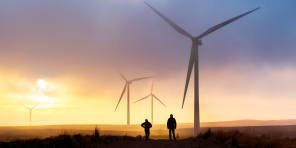PARTNER CONTENT by BAILLIE GIFFORD
This content was paid for and produced by BAILLIE GIFFORD
About 2 per cent of the solar energy that reaches the earth transforms into wind[1]. That might not sound like much, but it’s many times humankind’s annual energy use.
Not all of it is easily accessible. We’re unlikely to build wind farms in the middle of the Atlantic Ocean, for example. But they can be based far enough away from land that you can’t easily see them.
Offshore developments are admittedly more expensive to develop and maintain than onshore turbines. But they benefit from:
- higher wind speeds
- larger sizes
- avoidance of complaints and planning objections about spoilt views.
Ørsted, for example, has built the Hornsea One project about 75 miles off England’s east coast. Its wind turbines are more than double the height of most UK land-based counterparts. That helps them produce enough energy to power over one million homes.
Other companies benefiting from this trend include Vestas, Siemens Gamesa and Xinjiang Goldwind.
But it’s a select club.
“As you make turbines bigger and bigger, the technology and investment need to go up substantially,” explains Baillie Gifford investment manager Paulina McPadden.
“Companies have dropped out for that reason. There’s only a very small number now capable of making them.
“So there should be a pathway to the remaining firms making profits more durably.”
Solar price cuts
That’s not to say all the action is offshore.
The world’s solar capacity has doubled every 20 months since 2004[2]. And an observation known as Swanson’s Law has tracked related equipment falling in price by 20 per cent for each such period[3].
We have already reached the point when subsidy-free solar has become cheaper than coal[3], which should encourage large energy providers to switch. Soaring oil and gas prices are also encouraging homeowners and businesses to fit panels to their roofs as the break-even period shortens.
McPadden suggests that for Swanson’s Law to hold, further price savings will most likely come from finding ways to make the solar wafers and modules used to make solar panels at a lower cost.
“Scale could give a company an edge in this segment of the supply chain.”
Solar and wind energy projects also have predictable running costs.
“Companies are increasingly signing power purchasing agreements with renewable energy generators for up to 15 years,” McPadden explains.
“That gives them assured electricity supply at a pre-determined price, which appeals as businesses want certainty even if it costs them slightly more.
“The energy generator is also assured of getting that price, so they're not exposed to the volatility of the wholesale market, making it a win-win.”
Battery storage
Decarbonising electricity production will only go part of the way to meeting 2050’s net zero goals.
“Sometimes the wind doesn’t blow. Sometimes the sun doesn’t shine. You need some form of storage to balance out those ups and downs,” says McPadden.
That makes battery storage facility operators another investment opportunity. McPadden predicts they will base their business case on an ability to arbitrage the cost of electricity: buying it when it’s cheap because renewables are producing more than can be consumed and selling it back when the reverse is true.
She highlights Neoen as being a leader in the field. Last year it switched on Australia’s biggest grid-connected battery. It’s primed to play a vital role in helping the state of Victoria reach its 50 per cent renewable energy generation target by 2030.
“The issue with infrastructure owners and developers, however, is that they are very labour intensive and can’t scale quickly,” McPadden adds.
“So the equipment suppliers might be more interesting in a sense – battery makers like CATL, LG Energy and Northvolt.”
Hydrogen power
‘Green hydrogen’ production is another emerging energy storage solution. It involves using renewable energy to produce fuel from water via electrolysis.
The fuel could serve industries such as steelmaking, which require extremely high temperatures to manufacture their products and cannot simply switch from coal and other fossil fuels to electricity.
Hydrogen also has a role to play in long-distance, heavy-duty transport.
“Cargo ships, for instance, have massive energy demands,” says McPadden. “You can produce green hydrogen, turn it into ammonia and then use that as a fuel source. Freight trucking is another example.”
Two companies set to capitalise on this are ITM Power and Nel. Both make advanced electrolysers and are pioneers in hydrogen refuelling stations.
Many of the solutions mentioned above are capital intensive and won’t reach their full potential for years. So they require investors willing to think along longer time horizons than the norm.
However, the payoffs in tackling climate change and delivering strong returns should prove that patience has its rewards.
[1] https://css.umich.edu/publications/factsheets/energy/wind-energy-factsheet
[2] https://www.nature.com/articles/ncomms13728#ref-CR1
[3] https://www.synchrosolar.com/solar-prices-drop-what-is-swansons-law-with-graphic.html
Important information
As with any investment, capital is at risk. This article does not constitute, and is not subject to the protections afforded to, independent research. Baillie Gifford and its staff may have dealt in the investments concerned. The views expressed are not statements of fact and should not be considered as advice or a recommendation to buy, sell or hold a particular investment. Baillie Gifford & Co and Baillie Gifford & Co Limited are authorised and regulated by the Financial Conduct Authority (FCA).
Find out more
.png)






